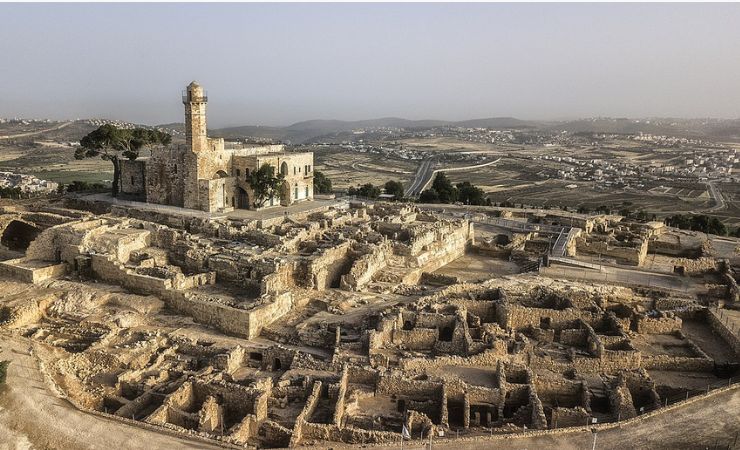Nebi Samuel: The Overlooked Gateway to Jerusalem’s Sacred Past
Nebi Samuel (Nabi Samwil) is an extraordinary historical and religious site located just a few kilometers outside Jerusalem. It is a place of pilgrimage for Jews, Muslims, and Christians alike.

Location
Located roughly 5 kilometers northwest of Jerusalem, Nebi Samuel rises high on a hilltop 908 meters above sea level providing panoramic views of the Holy City and the surrounding Judean Hills.
Biblical Context: Samuel’s Tomb and the Sacredness of Ramah
According to the Bible, the prophet Samuel—one of the most influential figures in Israel’s early history—was buried in his hometown of Ramah (1 Samuel 25:1). Samuel’s significance in the Bible cannot be overstated; he was the last judge of Israel and the prophet who anointed both King Saul and King David. His death and burial in Ramah added further importance to this already revered location.
While the Bible places Samuel’s tomb in Ramah, the exact location of Ramah has long been debated. Some scholars believe it is located further north in Ramallah or Rentis. However, over the centuries, the site of Nebi Samuel came to be associated with the prophet, and by the 12th century, Crusaders and local traditions embraced this identification



The Site's History: Layers of Civilizations
Archaeological evidence points to the existence of a settlement at the site as early as the First Temple Period (8th-7th century BCE), likely connected to the biblical Mizpah, a key site in ancient Israel. Excavations have uncovered pottery sherds and other artifacts that date back to this era, indicating its historical importance. During the Hellenistic/Hasmonean Period (2nd-1st century BCE), Nebi Samuel became part of the Hasmonean kingdom. A large village was established, with well-preserved homes and streets acting as a defensive position north of Jerusalem. This village, which thrived under Hasmonean rule, was suddenly abandoned during the reign of King Alexander Jannaeus, though the exact reasons remain unclear.
In the Byzantine Period (5th-7th century CE), a monastery was built at the site to honor the prophet Samuel. This monastery became a major destination for Christian pilgrims. However, much of the Byzantine structure was destroyed when the Crusaders arrived and built their fortress over the sacred site. The Crusaders fortified Nebi Samuel, constructing a large fortress to protect pilgrims and defend against Muslim forces. They built a church over what they believed to be the prophet Samuel’s tomb, enshrining the site as a place of Christian pilgrimage. The Crusader fortress stood for nearly a century before it was destroyed by Muslim forces after Saladin’s reconquest of Jerusalem in 1187
During the Ottoman Period (1730), the current mosque was constructed using the ruins of the Crusader fortress as its foundation.
Finally, today, Nebi Samuel is managed as part of a national park by the State of Israel. It is recognized as a site of shared religious significance for Jews, Muslims, and Christians. The site is open to worshippers of all faiths demonstrating the site’s unique multi-religious function.
The Crusaders and the Story of Mons Gaudii
When the Crusaders arrived in the Holy Land in the late 11th century during the First Crusade, they mistakenly identified Nebi Samuel as the biblical Ramah. This association was partly due to the site’s commanding height and proximity to Jerusalem, which made it appear as an ideal resting place for the prophet Samuel. By the time the Crusaders reached Nebi Samuel in 1099, local traditions had already established the site as Samuel’s tomb, and the Crusaders solidified this belief.
The Crusade itself was an epic and arduous journey. Launched in 1096 in response to Pope Urban II’s call to reclaim the Holy Land from Muslim rule, the First Crusade attracted thousands of European knights and soldiers. After years of battling through the Middle East, the Crusaders finally approached Jerusalem in June 1099. Nebi Samuel became their first major stop. From the top of the hill, they caught their first glimpse of the Holy City, and their joy at seeing Jerusalem after such a long and difficult voyage led them to name the hill “Mons Gaudii,” or “Mountain of Joy”.
What can be Found at Sebi Samuel?
Nebi Samuel today is a fascinating blend of religious structures and archaeological remains:
Tomb of Samuel and Synagogue: The underground chamber traditionally identified as the tomb of the prophet Samuel is located in the basement of the structure. Adjacent to the tomb is a small synagogue, which allows Jewish worshippers to pray at this sacred site. Jews particularly gather here on the 28th of Iyar, the anniversary of Samuel’s death.
Mosque on the Ground Floor: Directly above the tomb and synagogue is the mosque, constructed in 1730 during the Ottoman period. The mosque, still active today, serves Muslim worshippers who also venerate Samuel. Its prominent minaret offers panoramic views of the Jerusalem skyline and surrounding hills.
Crusader Fortress Ruins: Though much of the Crusader fortress has been lost to time, remnants of its defensive walls, stables, and the church that once stood here are still visible. The ruins evoke the site’s storied past and its role as a strategic military outpost.
Archaeological Finds: Excavations at Nebi Samuel have unearthed a range of fascinating finds, including pottery kilns from the Early Arab period, Byzantine mosaic floors, and well-preserved Hellenistic homes. These discoveries provide further evidence of the site’s long and varied history.
Nearby Sites
Ammunition Hill: A national memorial site dedicated to one of the fiercest battles during the Six-Day War. Located in Jerusalem, it offers visitors a chance to walk through bunkers and see exhibits about the battle.
Ein Kerem: This beautiful village, southwest of Jerusalem, is traditionally known as the birthplace of John the Baptist. It boasts several historic churches and monasteries, including the Church of St. John the Baptist and the Church of the Visitation.
Rockefeller Museum: Situated in East Jerusalem, this museum is an architectural gem housing a vast collection of artifacts from archaeological digs across Israel.



